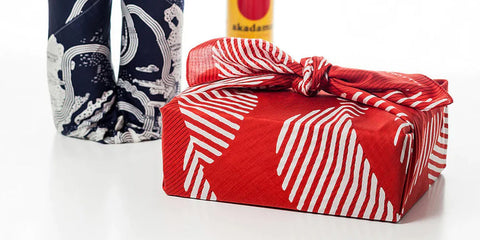Furoshiki, a square piece of fabric used for wrapping, has long been a part of Japanese culture. In most cases, it is used to wrap and carry things, but it can be used for any other purpose one could ever imagine.Its naming, in one theory, dates back to the Nara period (710-794). When taking a steam bath, in which medicinal herbs were cooked from under the sunoko (duckboard), people used to sit on straw and cloth laid on top of the sunoko. It is claimed that this cloth (shiki), which is used for bathing (furo), is the origin of the word "furoshiki".

Later, with the spread of public baths in the Edo period, the furoshiki became popular among the masses as a way to wrap and carry clothes. People also used to sleep with a furoshiki under their futon as a precaution against fire. The reason for this was, in the Edo period, fires were common, and during an emergency people needed to escape quickly with their futon and valuables. The furoshiki served this purpose, being used as a disaster prevention bag for a quick escape.

In recent years, Japanese furoshiki culture has been revived due to the trend toward an eco-friendly world and is now attracting attention overseas as well. Furoshiki is also being introduced for gift wrapping. Along with the spread of eco-friendly bags, furoshiki have become more familiar to us as an option. While cloth may be used like furoshiki in other countries as well, furoshiki in Japan may be a uniquely Japanese cultural item that has permeated modern lifestyles.

A decade ago, furoshiki had a slightly old-fashioned image, but today we can see sophisticated and beautiful designs that match modern fashions and even innovative designs that rewrite the concept of the furoshiki.

We would like to introduce a series of furoshiki brought to you by Link Collective, a manufacturer that reimagines the traditional Japanese furoshiki through innovative design collaborations with overseas designers.
These furoshiki, born from the ideas of designers from around the world and the handiwork of craftsmen in Japanese workshops, offer the possibility of an even greater future.The fabric material is 100% cotton. It is not the medium-thick fabric used for ordinary furoshiki, but a fine-textured, high-quality, lightweight fabric, like that used for handkerchiefs. It is suitable for wrapping, rolling, and decorating.

Link Collective was born in 2011 from the concept of two members, one based in Tokyo and the other in Los Angeles, to create new products that utilize traditional Japanese techniques with an international perspective.
The first priority was to reflect the excellence of the craftsmanship in the products, so each furoshiki is carefully made in a textile printing factory in Japan with a history of more than 50 years. Today, offers from all over the world are still coming in.
Link Collective continues to take on the challenge of introducing even more attractive products from Japan through collaborations with designers from around the world, far away.
These furoshiki can be used, not only for gift wrapping, but also as a bag, as a cloak or stole, or as interior decoration, and can be enjoyed in a variety of ways, depending on the creativity of the wearer. Although it is a single square piece of cloth, it can be used in a variety of ways, depending on the shape of the item to be wrapped and the way it is tied.

"TOKYO MANGA" was created in collaboration with "YamanoteYamanote", a unique design unit that has been creating various graphics on the theme of the Yamanote Line.
Inspired by the smells, sounds, and shapes of the city of Tokyo, the designs are a joy to behold.
"HIDA EXPRESS" was designed in collaboration with British artist Hannah Wardron, who was inspired by the view of Japan from the Hida Express in the Hida region.
This unique pattern was created by combining dynamic natural motifs and the world of Ukiyoe.
"FOLDED PAPER BLACK" is by British graphic designer Lucinda Newton-Dunn.
This artistic furoshiki is a flat furoshiki with a three-dimensional design based on origami motifs, expressed only by the thickness and thinness of the lines.
Furoshiki can be transformed into a sophisticated bag by attaching the leather strap(sold separately).
It is fun to think that one day the Japanese furoshiki, reborn in all its splendor, may be used around the world on a daily basis!





